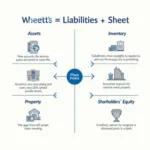Learning vocabulary is a crucial aspect of mastering the TOEIC test. If you’re looking for the Quickest Way To Learn TOEIC Vocabulary Step By Step, you’re in the right place. This guide will break down an efficient learning process, combining proven methods and effective strategies to help you supercharge your vocabulary quickly and efficiently.
Step-by-Step Guide to Mastering TOEIC Vocabulary
1. Focus on High-Frequency Words
One of the quickest ways to build solid TOEIC vocabulary is to concentrate on high-frequency words commonly found in the test. These are words that appear repeatedly across various TOEIC sections.
Here’s how you can approach it:
- Research the most frequent words often seen in TOEIC listening and reading.
- Create flashcards for 20-30 words per day.
- Review words daily using spaced repetition techniques to consolidate your memory.
Focusing on these essential words will help you cover a lot of ground at the beginning and improve your chances of recognizing them during the test.
Pro Tip: You can also pair this practice with revising the grammar structures and reading tips for TOEIC, which often go hand in hand with vocabulary learning. See more in how to review for TOEIC for reading section.
2. Categorize Vocabulary by TOEIC Sections
TOEIC has two primary sections: Listening and Reading. Creating vocabulary lists based on these sections can help you understand which words will be more useful in specific contexts.
- Listening section vocabulary: Focus on conversational terms, idiomatic expressions, workplace scenarios, and service-related words.
- Reading section vocabulary: Focus on formal business language, email phrases, report terminology, and contract-related words.
By categorizing vocabulary, you begin to understand the context in which these words are applied for more accurate usage.
3. Learn in Context: Use Example Sentences
Memorizing isolated words is never as effective as understanding how words are used in context. When learning a new word, always associate it with an example sentence relevant to TOEIC scenarios like business emails, meetings, or advertisements.
For instance, for the word “allocate,” which shows up in business-related contexts:
- Example: “The manager decided to allocate additional resources to the marketing department.”
This technique helps you remember the word and prepares you for logical use during the exam.
4. Apply the 20/80 Rule to Prioritize Vocabulary
The Pareto Principle (80/20 rule) can be a powerful formula for vocabulary learning. Essentially, 20% of the words you know will be relevant in 80% of your TOEIC test. Thus, to learn TOEIC vocabulary quickly, focus on the most impactful and relevant words first.
Actions:
- Use TOEIC-specific vocab sources to find the top 1000-1500 words that make the largest impact.
- Spend the majority of your study time reinforcing these common words.
Implementing this strategy can dramatically reduce unnecessary time spent on lower-frequency vocabulary.
5. Use the Power of Mnemonics and Visual Learning
Learning new words can be challenging. To speed up the process, use mnemonics or visualize the vocabulary. This makes word retention more effective.
- Mnemonics: Create short stories or memorable associations to help the word “stick” in your mind. For example, to remember the word invoice, imagine receiving a familiar bill from your favorite service provider.
- Visual aids: Associate words with images or videos where they naturally appear, such as pictures of office workplaces, tech equipment, or transport.
These strategies are practical solutions for quick memorization.
Here’s what Nguyen Hai, an experienced TOEIC instructor from Hanoi, advises:
“One of the biggest breakthroughs for my students is when they start using mnemonics to associate words with real-life experiences. It’s both faster and more fun than rote memorization.”
You can combine this method with self-study by checking out relevant tips from how to practice TOEIC without a teacher.
6. Practice Regularly with Vocabulary Quizzes
Testing yourself through vocabulary quizzes is a highly practical way to measure progress. You can use mobile apps or websites that focus on TOEIC vocabulary, or even create your own quizzes with the words you’ve learned.
Steps:
- Use spaced repetition apps such as Anki or Quizlet to test your vocab daily.
- Challenge yourself with 20 words quizzes every morning and evening.
- After each quiz, review the words you got wrong and reinforce them with more exposure.
This way, you ensure constant progress and better retention of words.
7. Pair Vocabulary Learning With Practice Tests
Perhaps one of the most efficient ways to lock in your vocabulary is by seeing it in action. Regularly taking practice tests not only familiarizes you with test formats but also helps you recognize vocabulary in a real-world TOEIC context. As you complete more tests, the words you’ve learned will appear more frequently, and you’ll start using them more naturally.
Do not underestimate the value of realistic practice. It accelerates learning and only takes about 2-3 practice tests per week to spot your vocabulary improvements. For more insights, check out tips for TOEIC for guaranteed success.
Conclusion
If you’re aiming for the quickest way to learn TOEIC vocabulary step by step, focus on high-frequency words, use categorization, and practice vocabulary in the context of TOEIC scenarios. Prioritize the most impactful words, and utilize mnemonics or quizzes to reinforce what you’ve learned.
By following this structured approach, you’ll rapidly expand your toeic vocabulary in no time. Consistent practice is essential, so make sure to pair vocabulary learning with practice tests for the best results. The road to success in any TOEIC exam is methodical, but with these steps, you’re well on your way to achieving a high score.
FAQs about Learning TOEIC Vocabulary
1. How many vocabulary words should I learn for the TOEIC?
It’s recommended to learn at least 1,000 of the most common TOEIC words. Prioritization is key, so focus on high-frequency terms first before moving to more specific or technical vocabulary.
2. What are the best resources for learning TOEIC vocabulary?
You can use flashcard apps like Quizlet or Anki, vocabulary sheets from TOEIC preparation books, and online quizzes specifically designed for TOEIC candidates.
3. Can I improve my TOEIC vocabulary without a teacher?
Yes! Independent learning is possible with tools like apps, practice tests, and daily revision schedules. Check out more advice on how to practice TOEIC without a teacher.
4. How often should I review my TOEIC vocabulary?
Daily review is necessary, focusing on a mix of previously learned words and new ones. Spaced repetition is an efficient method to embed the words into your long-term memory.
5. Why is learning vocabulary in context important for TOEIC?
Contextual learning helps you see how words are used in real-world scenarios, which is especially valuable for TOEIC, where business communications and daily conversations are the focus.
6. Can I learn TOEIC vocabulary in one month?
Yes, with an intensive study schedule, focusing on high-priority words and constant practice, you can significantly improve your TOEIC vocabulary in one month.
7. What are common vocabulary mistakes to avoid in TOEIC?
Avoid memorizing words out of context, skipping reviews, and neglecting essential business-related words typical for TOEIC.




